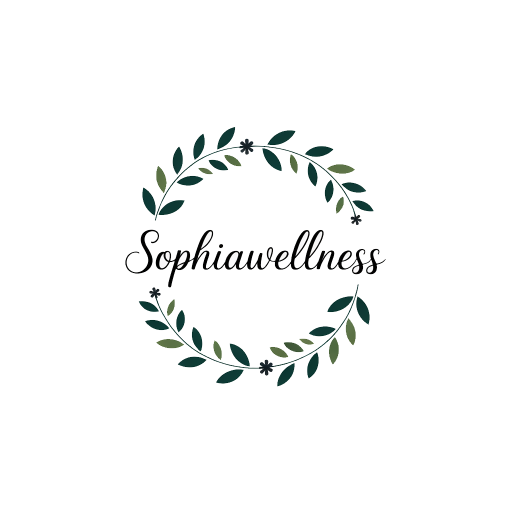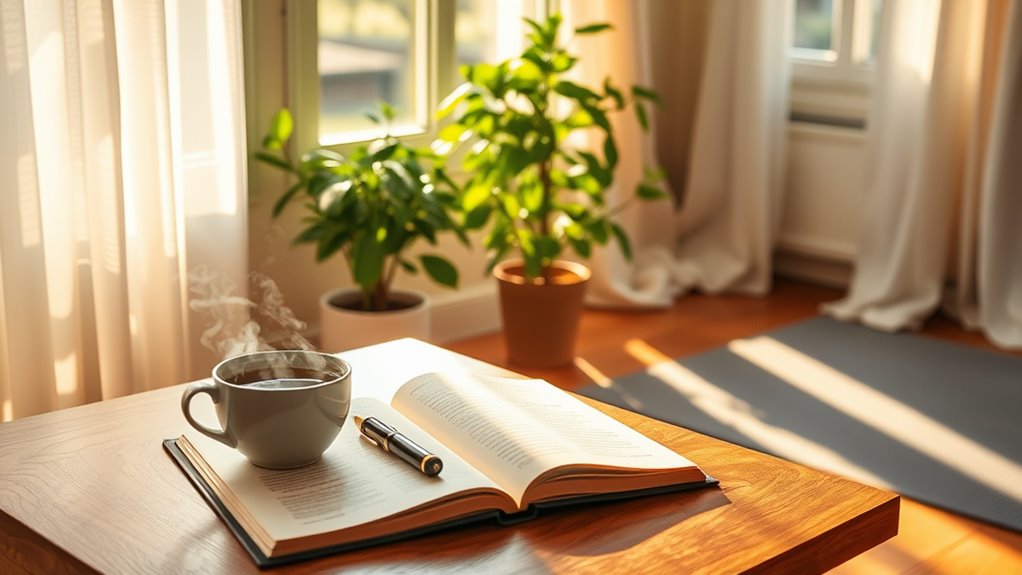How to Get Rid of Stress in 10 Minutes or Less
To get rid of stress in 10 minutes or less, try deep breathing exercises by inhaling deeply through your nose and slowly exhaling through your mouth. You can also practice progressive muscle relaxation by tensing and relaxing each muscle group. Mindful meditation or guided visualization can clear your mind. Aromatherapy and nature sounds enhance relaxation, while positive affirmations and gratitude practices shift your mindset. Want to discover more techniques to further reduce your stress?
Key Takeaways
-
Practice deep breathing exercises by inhaling deeply through the nose, holding briefly, and exhaling slowly through the mouth to calm the nervous system.
-
Engage in mindful meditation for five minutes, focusing on your breath to ground yourself and promote clarity.
-
Use progressive muscle relaxation by tensing and relaxing muscle groups to alleviate physical tension quickly.
-
Incorporate positive affirmations, such as “I am capable of handling any challenge,” to shift your mindset in moments.
-
Listen to nature sounds, like ocean waves or birds singing, to create a peaceful atmosphere and enhance relaxation.
Deep Breathing Exercises
When stress starts to creep in, deep breathing exercises can quickly ground you. By focusing on your breath, you create a bridge between your mind and body, enhancing your awareness and promoting relaxation.
Start by inhaling deeply through your nose, letting your abdomen expand. Hold that breath for a moment before exhaling slowly through your mouth. This rhythmic pattern not only calms your nervous system but also sharpens your concentration, making it a powerful tool for stress management. Incorporating breathing techniques into your routine can also enhance your overall well-being.
Pairing your breathing with a moment of meditation can amplify these benefits, allowing you to visualize your stress dissipating. As you practice, you’ll master the art of breathing, transforming moments of anxiety into opportunities for peace and clarity.
Progressive Muscle Relaxation
As you feel the tension building in your body, Progressive Muscle Relaxation (PMR) offers a quick and effective way to release it.
Start by finding a comfortable position, either sitting or lying down. Take a deep breath, then focus on one muscle group, like your hands. Tense the muscles tightly for five seconds, then release and notice the difference in sensation.
Move through your body—arms, shoulders, abdomen, and legs—tensing and relaxing each group. This method not only alleviates physical stress but also sharpens your awareness of tension patterns. Incorporating techniques like simple relaxation methods can further enhance your experience and promote a harmonious state of being.
Guided Visualization
Guided visualization can transport you to a peaceful place in just a few minutes. Close your eyes, take a deep breath, and picture a serene landscape. Imagine the colors, sounds, and scents surrounding you. This technique allows your mind to escape daily stressors and embrace tranquility. Additionally, incorporating breathing techniques into your visualization can enhance the overall calming effect.
| Steps | Description |
|---|---|
| Find a Quiet Space | Choose a place where you won’t be disturbed. |
| Choose Your Scene | Visualize a calming environment, like a beach or forest. |
| Engage Your Senses | Focus on the details—what do you see, hear, and feel? |
With practice, you’ll enhance your ability to create vivid imagery, leading to deeper relaxation and stress relief. Master this skill to reclaim your inner calm.
Mindful Meditation
Mindful meditation offers a powerful way to reduce stress in just a few minutes.
To begin, find a quiet space where you won’t be disturbed. Sit comfortably, close your eyes, and take a deep breath. Focus on the sensation of your breath entering and leaving your body. If your mind wanders, gently guide it back to your breath; this practice cultivates awareness and presence.
Aim for just five minutes, allowing each inhale and exhale to ground you. Notice any tension in your body, and consciously release it.
As you practice, you’ll sharpen your ability to stay centered amid life’s chaos. With consistent effort, mindful meditation can transform your relationship with stress, enhancing clarity and resilience. Furthermore, harnessing breath through specific techniques can deepen your experience, providing even greater relaxation and mental clarity.
Quick Stretching Routines
Sometimes, a quick stretch can do wonders for your stress levels, and you don’t need much time to reap the benefits.
Incorporating short, effective stretching routines into your day can invigorate your body and mind. Here are four stretches you can do in just a few minutes:
- Neck Roll: Gently roll your head to release tension.
- Shoulder Shrugs: Lift and drop your shoulders to alleviate tightness.
- Forward Bend: Reach toward your toes to stretch your back and hamstrings.
- Seated Twist: Sit tall, twist your torso to each side to enhance spinal flexibility.
These stretches not only relieve physical tension but also create a sense of calm and clarity, helping you regain focus and balance quickly. Additionally, pairing these stretches with breathing techniques can further enhance your relaxation and mindfulness.
Journaling for Clarity
Journaling can be a powerful tool for clearing your mind and reducing stress. By putting your thoughts on paper, you can gain clarity and insight into your feelings.
Let’s explore the benefits of journaling, effective writing techniques, and some prompts that can help you get started.
Benefits of Journaling
When life’s pressures start to pile up, taking a moment to jot down your thoughts can provide instant clarity. Journaling acts as a powerful tool for self-reflection, allowing you to process emotions and gain insights.
Here are some benefits you’ll experience:
-
Emotional Release: Writing helps you unload pent-up feelings, reducing stress and anxiety.
-
Enhanced Focus: Putting your thoughts on paper sharpens your mind, helping you prioritize and tackle tasks more effectively.
-
Increased Self-Awareness: Regular journaling fosters a deeper understanding of your thoughts and behaviors, guiding personal growth.
-
Problem Solving: Clarifying your thoughts can illuminate solutions you didn’t recognize before, empowering you to take action.
Embrace journaling, and watch as it transforms your mental clarity and emotional resilience.
Effective Writing Techniques
While many people struggle to find the right words to express their thoughts, using effective writing techniques can make journaling more impactful and clear.
Start by setting a specific intention for your journaling session. This focus helps you hone in on what truly matters. Use short, declarative sentences to articulate your thoughts, making them easier to digest.
Don’t worry about grammar or structure; let your ideas flow freely. Embrace the power of bullet points or lists for clarity, especially when dealing with complex emotions.
Finally, review your entries periodically. This reflection not only enhances understanding but also highlights patterns in your stress.
Prompts for Clarity
To gain clarity in your thoughts, consider using specific prompts that guide your writing. Journaling can be an effective tool for uncovering your emotions and thoughts.
Here are four prompts to help you achieve clarity:
-
What’s weighing heavily on my mind right now?
-
What do I truly desire, and what’s stopping me from pursuing it?
-
How do I feel about my current situation, and why?
-
What’s one step I can take today to move closer to my goals?
Aromatherapy Techniques
Aromatherapy techniques offer a quick and effective way to alleviate stress in just minutes.
Start by selecting essential oils known for their calming properties, like lavender or chamomile. Use a diffuser to disperse the scent throughout your space, or simply inhale from the bottle for an instant lift.
You can also create a calming roller blend by mixing essential oils with a carrier oil and applying it to pulse points. For an added touch, soak a cotton ball in your chosen oil and place it near your workspace.
As you breathe in the soothing aromas, focus on your breath, letting go of tension. In a few moments, you’ll feel your stress begin to melt away, enhancing your clarity and focus.
Nature Sounds for Relaxation
If you’re looking for another quick way to reduce stress, consider the calming effects of nature sounds. These soothing melodies can transport you to a serene environment, helping you regain focus and tranquility.
Here’s how you can incorporate nature sounds into your routine:
- Ocean Waves: Feel the rhythm of the tides wash away your worries.
- Birdsong: Let the cheerful chirping uplift your mood and spark joy.
- Rustling Leaves: Experience the gentle whispers of the wind, grounding your thoughts.
- Rainfall: Allow the soft patter of rain to create a peaceful backdrop, promoting relaxation.
Just a few minutes with these sounds can greatly enhance your mental clarity and emotional balance, empowering you to tackle the day ahead.
Positive Affirmations
Five powerful positive affirmations can shift your mindset and reduce stress in just minutes.
Start by declaring, “I am capable of handling any challenge.” This affirmation empowers you to face obstacles with confidence.
Next, say, “I choose to focus on the positive.” This helps redirect your thoughts away from negativity.
Another strong affirmation is, “I am worthy of love and success.” Reminding yourself of your worth boosts self-esteem.
Follow this with, “My mind is calm, and my body is relaxed.” Visualize tranquility as you say it.
Finally, affirm, “I attract positivity into my life.” This opens your mind to opportunities.
Repeat these affirmations daily, and watch your stress diminish while you cultivate a masterful mindset.
Simple Gratitude Practices
Building on the power of positive affirmations, incorporating simple gratitude practices can further enhance your stress relief efforts.
By making gratitude a daily habit, you’ll cultivate a mindset that invites joy and reduces anxiety.
Here are four impactful gratitude practices you can implement in just minutes:
-
Gratitude Journaling: Write down three things you’re thankful for each day. This shifts your focus from stress to appreciation.
-
Thank You Notes: Send a quick note to someone who’s made a difference in your life. Expressing gratitude strengthens relationships.
-
Mindful Moments: Take a minute to reflect on what you appreciate in your surroundings—nature, a friend, or a warm cup of coffee.
-
Daily Affirmations: Combine gratitude with affirmations to reinforce positivity in your life.
These practices can transform your perspective and reduce stress.
Frequently Asked Questions
Can I Practice These Techniques Anywhere, Anytime?
You can practice these techniques anywhere, anytime. Whether you’re at work, home, or on the go, incorporating them into your daily routine will help you effectively manage stress and enhance your overall well-being.
How Often Should I Use These Stress-Relief Methods?
You’ll want to use those stress-relief methods regularly, like a daily cup of coffee. Consistency builds mastery, so make it a habit. The more you practice, the better equipped you’ll be to handle life’s pressures.
Are These Techniques Suitable for Children?
Yes, these techniques are suitable for children, as they help them manage emotions effectively. You can adapt methods to their age and understanding, ensuring they’re engaging and beneficial for their mental well-being.
What if I Feel More Stressed After Trying These Methods?
If you feel more stressed, don’t worry; it’s normal. Sometimes, initial reactions can amplify stress. Assess your technique, adjust your approach, and give yourself permission to explore different methods until you find what works best for you.
Can I Combine Multiple Techniques for Better Results?
Absolutely, you can combine multiple techniques for better results. Experiment with different combinations, like deep breathing and visualization, to discover what works best for you. Tailor your approach to maximize your effectiveness and enhance your mastery.





